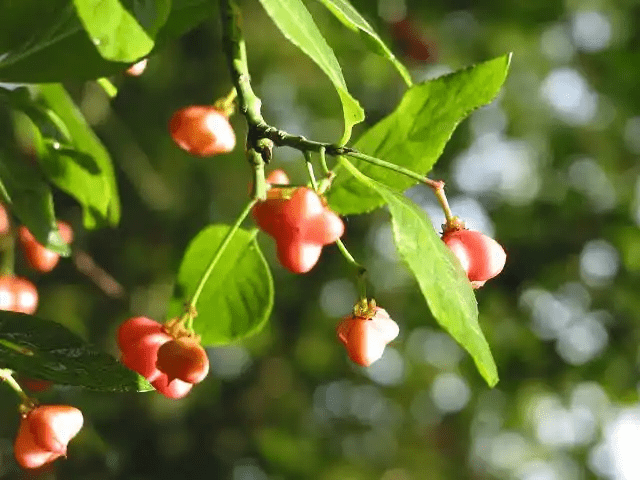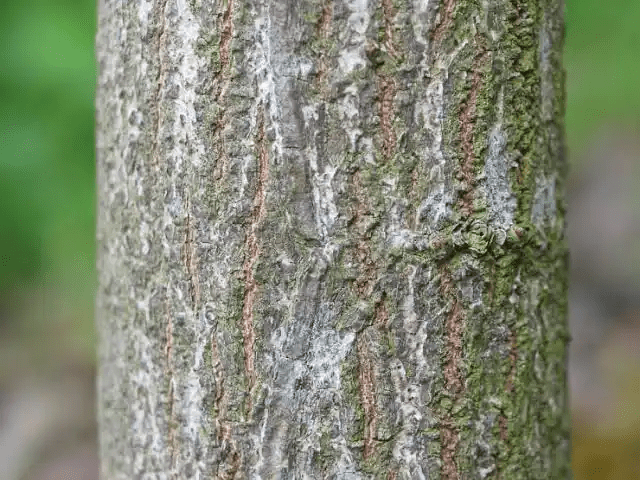Spindle Bark, scientifically known as Euonymus europaeus, refers to a deciduous shrub or small tree native to Europe and parts of Asia. This plant is a member of the Celastraceae family and is recognized for its unique features, including vibrant autumn foliage and distinctive fruits.
Key characteristics of the Spindle Bark include its opposite, elliptical leaves that turn vibrant shades of pink, red, and purple in the fall. The plant produces small, inconspicuous greenish flowers in late spring or early summer.
Following the flowering period, Spindle Bark develops striking pinkish to reddish-orange capsules, which split open to reveal bright orange seeds. These seeds are encased in fleshy arils, adding to the visual appeal of the plant.
The ornamental qualities of Spindle Bark make it a popular choice in gardens and landscapes, particularly for its autumn display. Its adaptability to various soil types and tolerance of different light conditions contribute to its versatility in garden design.
Despite its aesthetic appeal, it’s important to note that certain parts of the Spindle Bark, especially the seeds, contain alkaloids and glycosides that can be toxic if ingested. Therefore, caution is advised, especially in households with children or pets.
In addition to its ornamental uses, some traditional uses of Spindle Bark involve its bark and roots. Historically, parts of the plant have been used in herbal medicine, although such uses should be approached with caution due to the potential toxicity of certain compounds found in the plant.
From an ecological perspective, Spindle Bark can contribute to biodiversity by providing habitat and food for birds and other wildlife. The vibrant fruits attract birds, which aid in seed dispersal.
Cultivating Spindle Bark generally requires well-drained soil and a location that receives full to partial sunlight. Pruning can help maintain the desired shape and size of the plant.
Euonymus europaeus, commonly known as Spindle Bark, is a visually appealing shrub or small tree valued for its ornamental qualities, particularly its autumn foliage and colorful fruits. While it can be a charming addition to gardens, it’s essential to be aware of its potential toxicity and take appropriate precautions when handling or planting it in environments with children and pets.
The Botanical Description of Spindle Bark
1. Bark Texture: Smooth yet slightly rough surface, offering tactile intrigue.
2. Leaf Arrangement: Leaves alternate along the stem, aiding identification.
3. Flower Characteristics: Clusters of vibrant blossoms attracting pollinators.
4. Growth Habit: Versatile growth, adapting to diverse environmental conditions.
5. Foliage Shape: Elliptical or ovate leaves with serrated edges.
6. Trunk Structure: Sturdy and well-defined trunk structure for resilience.
7. Root System: Robust root system anchoring the plant securely.
8. Growth Rate: Moderate growth rate, making it manageable for cultivation.
The Geographic Distribution of Spindle Bark
1. Native Habitats: Thrives in temperate forests to subtropical regions.
2. Continental Presence: Established on multiple continents globally.
3. Altitudinal Range: Versatile adaptability across lowlands to mountainous terrains.
4. Soil Preferences: Favors well-drained soils, adaptable to various types.
5. Climate Tolerance: Thrives in diverse climates, from arid deserts to tropical regions.
6. Human Introduction: Cultivated globally as an ornamental plant.
7. Ecological Impact: Plays a role in ecosystems, serving as habitat and food.
The Chemical Composition of Spindle Bark
1. Alkaloids: Rich in alkaloids with diverse pharmacological effects.
2. Tannins: Abundance of astringent tannins for medicinal properties.
3. Flavonoids: Colorful pigments contributing to visual appeal and potential health benefits.
4. Terpenoids: Presence of terpenoids for resilience and environmental interaction.
5. Essential Oils: Aromatic essential oils for fragrance and potential applications.
6. Phenolic Compounds: Antioxidant phenolic compounds for overall health.
7. Resins: Resins with adhesive and protective qualities against pests.
8. Glycosides: Presence of glycosides with potential therapeutic properties.
9. Saponins: Saponins with foaming properties and diverse biological activities.
10. Proteins: Essential proteins contributing to plant growth and development.
11. Carbohydrates: Fundamental carbohydrates as energy sources and metabolic contributors.
12. Lipids: Lipids, including fats and oils, for structural and physiological roles.
13. Minerals: Essential minerals contributing to the plant’s nutritional profile.
Read Also: 20 Medicinal Health Benefits Of Bambusa vulgaris (Bamboo)
The Medicinal Health Benefits Of Spindle Bark (Euonymus europaeus)

1. Anti-inflammatory Properties: Spindle bark exhibits anti-inflammatory effects, aiding in reducing inflammation-related conditions such as arthritis.
2. Antioxidant Benefits: Compounds within spindle bark act as antioxidants, combating oxidative stress and potentially reducing the risk of chronic diseases.
3. Digestive Aid: It’s believed to support digestive health, easing discomfort and aiding in digestive processes.
4. Cardiovascular Support: Certain constituents may contribute to heart health, potentially lowering the risk of cardiovascular issues.
5. Immune System Enhancement: Studies suggest spindle bark may bolster the immune system, aiding in fighting infections.
6. Analgesic Effects: It’s reported to possess mild analgesic properties, potentially alleviating minor pains.
7. Respiratory Health: Traditional uses include aiding respiratory conditions such as coughs and colds.
8. Skin Conditions: Some applications involve treating skin ailments due to its potential anti-inflammatory effects.
9. Antimicrobial Properties: It may exhibit antimicrobial effects against certain pathogens.
10. Diuretic Effects: Used traditionally as a diuretic, aiding in kidney and urinary health.
11. Stress Relief: Some cultures utilize spindle bark for its potential stress-relieving properties.
12. Menstrual Health: Traditional applications include managing menstrual discomfort.
13. Anticancer Potential: Preliminary studies hint at possible anticancer properties, but more research is needed.
14. Wound Healing: Applied topically, it’s believed to aid in wound healing due to its reported antimicrobial and anti-inflammatory properties.
15. Neuroprotective Effects: There’s interest in its potential to support brain health and protect against certain neurological conditions.
The Methods of Usage to Achieve the Provided Health Benefits Of Spindle Bark (Euonymus europaeus)
1. Herbal Infusion: Making an herbal tea from spindle bark is a common method for internal use.
2. Tinctures: Extracts in alcohol or glycerin form are utilized for easy consumption.
3. Topical Applications: Ointments or poultices are used for skin conditions and wound healing.
4. Capsules or Tablets: Available in supplement form for convenient intake.
5. Decoctions: Boiling the bark to create a concentrated liquid for medicinal purposes.
6. Inhalation: Inhalation of steam from spindle bark-infused water for respiratory benefits.
7. Compresses: Soaked cloth with a spindle bark solution applied to affected areas for localized benefits.
8. External Wash: Utilized for skin-related issues by washing the affected area with a prepared solution.
The Side Effects Of Using Spindle Bark Medicinal Plant
1. Gastrointestinal Upset: Excessive intake may lead to stomach discomfort or irritation.
2. Allergic Reactions: Some individuals might experience allergic responses to spindle bark.
3. Toxicity: Ingesting large amounts can lead to toxicity due to certain alkaloids present in the plant.
4. Skin Irritation: Topical applications may cause skin irritation in sensitive individuals.
5. Interaction with Medications: Spindle bark may interact with certain medications, affecting their efficacy.
Read Also: 10 Medicinal Health Benefits Of Lemon Grass (Cymbopogon citratus)
The Scientific Research and Studies of Spindle Bark (Euonymus europaeus)

1. Antioxidant Properties: Numerous studies delve into the antioxidant potential of spindle bark, highlighting its role in combating oxidative stress.
2. Anti-inflammatory Effects: Scientific research suggests that certain compounds in spindle bark exhibit anti-inflammatory properties, supporting its traditional use in alleviating inflammatory conditions.
3. Immunomodulatory Activity: Research indicates that spindle bark may have immunomodulatory effects, influencing the immune system’s response to various challenges.
4. Phytochemical Composition: Comprehensive studies analyze the plant’s phytochemical composition, identifying specific compounds responsible for its medicinal properties.
5. Antimicrobial Action: Scientific investigations explore the antimicrobial properties of spindle bark, evaluating its effectiveness against various pathogens.
6. Cardiovascular Impact: Research assesses the potential cardiovascular benefits of spindle bark, examining its impact on heart health.
7. Neuroprotective Potential: Preliminary studies suggest that certain constituents in spindle bark may have neuroprotective effects, sparking interest in its role in brain health.
8. Analgesic Properties: Scientific scrutiny investigates the analgesic effects of spindle bark, contributing to the understanding of its pain-relieving capabilities.
9. Gastrointestinal Effects: Research delves into the impact of spindle bark on the gastrointestinal system, exploring its potential benefits and risks.
10. Wound Healing Properties: Studies explore the application of spindle bark in wound healing, assessing its efficacy in promoting tissue repair.
11. Anticancer Investigations: Ongoing research examines the potential anticancer properties of spindle bark, though more studies are needed for conclusive evidence.
12. Respiratory Health Studies: Scientific exploration assesses the impact of spindle bark on respiratory health, investigating its traditional uses in addressing respiratory conditions.
The Safety Precautions and Recommendations In Using Spindle Bark (Euonymus europaeus) Medicinal Plant
1. Consultation with Healthcare Professionals: Before incorporating spindle bark into any health regimen, it is advisable to consult with healthcare professionals, especially for individuals with pre-existing medical conditions.
2. Dosage Guidance: Adherence to recommended dosages is crucial to prevent potential adverse effects associated with excessive intake of spindle bark.
3. Allergic Reactions: Individuals with known allergies to related plants should exercise caution, as allergic reactions are possible.
4. Pregnancy and Breastfeeding: Pregnant or breastfeeding individuals should consult healthcare providers before using spindle bark due to potential effects on reproductive health.
5. Interaction with Medications: It’s essential to inform healthcare providers about any medications being taken, as spindle bark may interact with certain drugs.
6. Avoiding Self-diagnosis: While spindle bark shows promise, self-diagnosis and treatment should be avoided, and professional guidance sought for accurate assessment and management.
FAQs About Spindle Bark (Euonymus europaeus) Medicinal Plant
1. Is Spindle Bark Safe for Children?
While it has been traditionally used, caution is advised. Consult with a pediatrician before administering to children.
2. Can Spindle Bark Interact with Blood Pressure Medications?
Yes, it may interact. Consult with a healthcare professional if you are taking blood pressure medications.
3. Are There Any Known Allergic Reactions?
Some individuals may experience allergic reactions. Discontinue use if any adverse reactions occur.
4. What is the Recommended Dosage for Spindle Bark Supplements?
Dosage recommendations may vary. Consult with a healthcare provider for personalized advice.
5. Can Spindle Bark Be Applied Topically?
Yes, topical application is common for skin-related issues. Follow proper dilution and application guidelines.
6. Is Spindle Bark Safe During Pregnancy?
Pregnant individuals should consult healthcare providers before using spindle bark due to potential effects on reproductive health.
7. How Long Does it Take to See Results in Medicinal Applications?
Results may vary. Patience is advised, and consistency in usage is key.
8. Can Spindle Bark Be Consumed Raw?
It is not recommended to consume raw spindle bark. Proper processing or extraction methods are preferred for medicinal use.
9. Are There Any Known Drug Interactions with Spindle Bark?
Yes, spindle bark may interact with certain medications. Inform healthcare providers about all medications being taken.
10. What Precautions Should Be Taken for Individuals with Liver Conditions?
Individuals with liver conditions should exercise caution and consult healthcare providers before using spindle bark.
11. Can Spindle Bark Be Used for Chronic Pain Management?
While it may have analgesic properties, consultation with a healthcare provider is necessary for chronic pain management.
12. Is Spindle Bark Legal to Cultivate and Use?
Legal status may vary by region. Check local regulations before cultivating or using spindle bark.
Read Also: Interesting Facts About Giraffe

